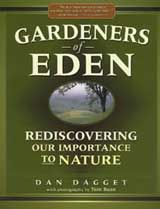Index of articles and links

|
Australian author reveals comprehensive solutions to the climate crisis. Enterprise, Oregon, July 2007--Biosphere Media has published a US/UK edition of Allan Yeomans's controversial book Priority One: Together We Can Beat Global Warming.
Allan Yeomans has a background in physics, chemistry, meteorology, and agriculture. He realized that the rapid development of soil organic matter could solve the global warming problem, in combination with a switch to nonfossil energy sources. But most scientists, experts, organizations, and governments are unfamiliar with soil-enhancing farming and grazing methods, or the large and rapid increases in soil organic matter that they were achieving. "The undue influence of the coal, oil, and gas industries on every aspect of American politics has blinded Americans to the opportunities we have to stop global warming," he said. Continue article...
Forestry that Works. 30-minute film about excellent forest stewardship, highlighting the opportunities for public land management, and some observations on fire. Forestry that Works page, with a trailer and ordering info.
Discover the most common cause of droughts and floods worldwide. Viewable as a Flash movie with quiz, HTML slide show, or downloadable Flash and PowerPoint versions for classroom use, presentations, and offline viewing. In 6 languages:
Water vapor may be biggest contributor to higher global temperatures On Environmental News Network website. These new findings support the theory that grassland expansions cause global cooling by capturing atmospheric carbon and water. When deserts grow, bare ground increases, carbon capture decreases, and higher soil temperatures evaporate more water. Desertification now affects 1/4 of Earth's land area. Do expanding deserts drive global warming?
Conservation refugees: when protecting nature means kicking people out by Mark Dowie. Research shows that removing indigenous people from nature reserves lowers biodiversity. Yet indigenous people now cite conservation as the #1 threat to their traditional ways of life. On the Orion Magazine website. (Related: Dan Dagget's Gardeners of Eden.)
Social Change: A 7 Step Social Marketing Approach: Les Robinson explores how the usual "education" model of social change is insufficient, and proposes an alternative.
Animal impact: how trampling benefits grassland ecosystems by Joy Livingwell. Grasslands are adapted to grazing and trampling. Without it, they suffer environmental damage. Photos.
Desert or Diversity? One grazed area is suffering such severe desertification that livestock are starving. The adjoining land has so much extra forage that it has taken many of the extra livestock, and wild game has reappeared. The only difference is management. Article with photos by Allan Savory on the Range Magazine website.
Biological soil crusts -- how well do they really protect soil? by Joy Livingwell. Widely regarded as beneficial protectors of exposed soil, soil crusts usually indicate severe environmental damage, and may interfere with ecosystem recovery. Photos.
Preparing soil for rain by Chris Henggeler. Photos demonstrate the difference between land that sheds rain, and land that absorbs it. On the Environmental Literacy website.
Gardeners of Eden: Rediscovering Our Importance to Nature by Dan Dagget. Review. |
Gardeners of Eden: Rediscovering Our Importance to Nature — book review by Peter Donovan. Author Dan Dagget explains how human management has been crucial factor in creating many of the environments that we mostly now regard as natural, and what that means for ongoing preservation and restoration of today's landscapes.
Holistic Management in Russian: Sam Bingham's book Grassroots Restoration: Holistic Management for Villages is now available for free download in Russian. One of the best books ever written about Holistic Management, Sam's 90-page book is also available in French and English.
Steve Rich interviews rangeland observers on the validity of federal data: "When I first start to work with anti-ranching professors and other activists in and out of government," Tommie Martin said, "anything positive on any ranch is seen by them as an endangered natural treasure that the cows just haven't managed to kill yet. They're usually wonderful, sensitive, well-meaning people. They're very learned in Latin taxonomy and methodologies. The thing is they've been conditioned to go along and not put their butts on the line. As for experience [Martin teaches by direct observation on-site], you'd think some of them were raised in a closet."
The other side of the problem is the bunch she calls "tunnel-vision ranchers," who focus mostly on their animals. Some years ago, the president of one of the cattlemen's groups admitted proudly that he couldn't tell an annual from a perennial. He explained that he "hired consultants for that." He is not typical of ranchers, but that attitude does exist.
Martin tells both groups that if they put their assets of rancher experience and educated expertise together, they'll be very effective. Science has already benefited greatly from ranchers' keen, questioning, year-in-year-out observations. If scholars then use the fundamentalist science (where rancher/scientist teams' conclusions are drawn from long-term, real-world scale data, not inferred by brief observations) that Dr. Rinne and other responsible scientists call for, breakthroughs occur and the resource benefits.
Older posts
